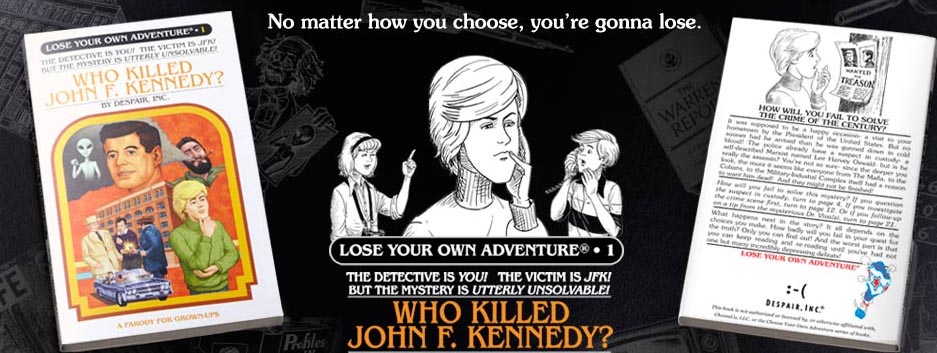A few weeks ago, I received a package in the mail from an outfit going by the name of Despair, Inc. I was certain that the flaps would be lacquered with ricin and that the envelope would include some VHS tape containing a fourth-rate Dom DeLuise movie. But the despair, as it turned out, was more commonplace, merely summoning a few stray kernels of childhood misery that I falsely believed recent therapy had expunged.
There was a book inside called Who Killed John F. Kennedy?, which expertly mimicked the Choose Your Own Adventure books I remembered reading as part of an incentive program at an elementary school library. I flipped through the book. The fonts were exact. The beloved Choose Your Own Adventure balloon, which had seemed designed to prepare children for some wine tasting trip to Napa, was deflated. Paul Stranger’s illustrations captured the long chins and bubbly noses of largely Caucasian figures who did not quite reflect the ethnic makeup of the public schools I attended in the 1980s, but which implied something safe for the many bigoted Archie Bunker clones thriving in the hick hood I grew up in. There were even many italicized messages to Go to the next page at the bottom of many pages when there was clearly no other option. (I recall discussing this mystery with my fellow second-graders. Did the Choose Your Own Adventure people think that we would just sit there and leave the page flattened and unturned? Or had this been some intelligence test contrived by a bitter and underpaid Bantam book designer?)
I was keen to lose my adventure, especially given the sour pressure exerted by an accompanying “book critic guide” which declared that failure to read the book would make me complicit in covering up one of the greatest tragedies of the 20th century. I had already committed substantial damage to literature simply by venturing a few strong opinions over the years. This seemed too gargantuan a responsibility to ignore.
I was a little unsettled that “Despair Inc.” was listed as the author. “Inc.” does not quite have the ring of “Packard” or “Montgomery.” It didn’t take me long to learn that some guy named Justin Sewell was the author of this book and that Michael Schaub, a man who once fought alongside me with Dos Passos and Orwell during the Litblog Civil War, had contributed “additional material.”
There were several surprises in the book. The first was a series of referential numbers taking me to the back of the book, where I discovered information about John Abt, Dan Rather, and The Lake Pontchartrain Film. The original Choose Your Own Adventure books had never been especially concerned about conveying an educational experience. (To be fair, Your Code Name is Jonah, Prisoner of the Ant People, and The Third Planet of Altair weren’t exactly titles designed with pedagogy in mind.) I approved of this enhancement.
My second astonishment was how unexpectedly prolix some of the book’s sections were. While I was pleased to talk with Professor Coppens about Area 51 and hide behind a conveniently placed rock, I was a bit alarmed when I turned to page 110, after informing my mom that I wished to clean dog pee from my laundry, only to find a three page section, where I was humiliated by my rival detective Jenni Mudd. Surely humiliation involves more choice and less acquiescence. On the other hand, if I was fated to lose, this probably made sense. I’m sure there were fistfights in the undoubtedly spacious Despair, Inc. boardroom over these modest artistic decisions.
It was nice for the book to ask me if I wanted to put on a blindfold or not. And I enjoyed the way that Who Killed John F. Kennedy? forces the reader to question her position on J. Edgar Hoover when following a certain path. I have suspected, especially in considering Escape (the Choose Your Own Adventure title in which the United States is split into three violent territories), that R.A. Montgomery was some wild-eyed libertarian, perhaps a closet gun nut, who wanted to put the blame on kids for making wrong decisions, thereby imparting an austere civics lesson with his contributions to the Choose Your Own Adventure series. Edward Packard struck me as the more easygoing member of the team, very keen on the word “you” and maintaining a sense of wonder. Who Killed John F. Kennedy? reads like a fusion of the Packard and Montgomery sensibilities, resulting in a suitably schizophrenic reading experience that should satisfy most conspiracy theorists.
